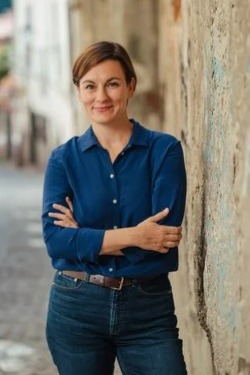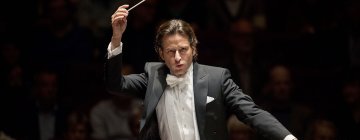The Cabrillo Festival of Contemporary Music began this year’s season on Friday, August 1, with Lumina. Prior to the concert, Executive Director D. Riley Nicholson interviewed conductor Daniella Candillari and the evening’s concertmaster Justin Bruns outside on Church Street, enabling concertgoers to listen while enjoying meals from food trucks stationed on site or from nearby restaurants. Candillari and Bruns both spoke of the special atmosphere at Cabrillo and the sense that making music with the organization is a true collaborative project.
That sense carried over into the Santa Cruz Civic Auditorium, where Candillari led four works that featured vast sheets of hushed but tensely expectant sound, especially at the beginning of each piece. These openings were based on held string tones, whose low volume did not quite conceal dissonance, and also variously included muted brass, bowed vibraphone, two pianos playing notes a quarter-tone apart, and a solo violin.
The solo violin belonged to Jennifer Koh, playing Missy Mazzoli’s Procession— a violin concerto written for Koh. Composed during the pandemic and inspired by medieval healing spells, it consists of five short interconnected movements. More than most recent concertos, Mazzoli’s sounded as if it was pitting the violin against the orchestra. Koh ground out a raw tone, sawing her bow or double-stopping with intensity, and going her own way rhythmically against the orchestra which mutated from still shimmerings to held growls, snapping strings, and other exclamations commenting on the musical journey. At the end, the orchestra vanished into silence and Koh concluded with a clunk.
As the centerpiece of the concert, Mazzoli’s work commanded attention by refusing to comfort the listener. Instead, it captivated through passion and ferocity.
The evening’s titular composition, Nina Shekhar’s Lumina, was a much shorter piece. Here, the quietly dissonant background surged forth into intensely loud waves which quickly receded. This is intended, the composer says, to symbolize the contrast between dark and light, shadow and radiance, but it speaks clearly enough simply as sound.
The remaining two pieces, both by Cabrillo veteran John Corigliano, were suites taken from dramatic works. Each incorporates crisp and pronounced contrast in volume and character. But they do so in different ways.
Phantasmagoria is a journey in the style of a tone poem through the features of Corigliano’s 1991 opera The Ghosts of Versailles. Based in quiet spectral music for the ghosts, slow and anticipatory, it frequently shifts gears into fast and comic music inspired by 18th century opera buffa. However, the work more often resembles the sort of tumbling silliness found in old Warner Brothers cartoons. Tiny nuggets of quotations from Mozart and Rossini litter the landscape at one point. Though the actual content differs substantially, the general effect of the piece resembles the suite from Richard Strauss’s Der Rosenkavalier.

The concert’s concluding work Three Hallucinations, presents linked yet distinct pieces, with most of the material taken directly from Corigliano’s score for the 1980 film Altered States, directed by Ken Russell. Three Hallucinations gives more of an impression that it’s trying to tell bits of a story than does the more chaotically organized Phantasmagoria. Wind instruments honking in the style of Arab street music, French horns blatting like kazoos, or an out-of-tune offstage piano playing “Rock of Ages” may communicate messages to listeners who’ve seen the movie. Both the first and third movements rise to tumultuous climaxes. The finale is sometimes compared to Igor Stravinsky, but to my ears more resembled the raw primitivism of Sergei Prokofiev’s Scythian Suite.
The entire concert was held together by Candillari’s tightly controlled conducting. Her command over the program’s frequent changes in tempo, mood, and character was inspiring and let the music breathe. Her experience as principal conductor of Opera Theatre of Saint Louis undoubtedly helped her convey the dramatic sense of these works. The musicians of the Festival Orchestra appeared to relish the challenges of these scores. The outcome once again demonstrated how Cabrillo can take contemporary music, no matter how difficult, and make it intriguing and enticing.

